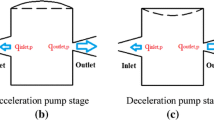Abstract
A valveless micropump actuated by thermal bubbles which are generated by an electrode heater mounted with a pair of diffuser nozzles has been numerically studied by commercial CFD software FLUENT. The relationships between the net flow rate and the superheating and heat supplying frequency have been investigated. The depth of the diffuser-nozzle micropump is 200 μm, the diameter of the actuating chamber is 1 mm, and a pair of diffuser nozzles whose gap has been expanded from 30 μm to 274 μm with an open angle of 7° are connected to the actuating chamber. The working fluid is methanol. In the numerical simulation, the flow pattern is laminar. The results show that the pump has different optimal driving frequencies at different superheating. A cycle resulting from bubble growth and shrinking costs more time at higher superheating temperature; different superheating has different optimal driving frequency; when the superheating increases, the maximum volume flow rate and the maximum pump pressure will increase simultaneously, and the optimal driving frequency decreases as well, the maximum volume flow rate and pump pressure also have the same tendency; in the condition of uncontrolled condensing, the bubble shrinking process is longer than the growth process, thus it is the determining factor to affect the pump performance. The maximum volume flow rate is 9.02 μL/min at ΔT = 15°C, and the maximum pump pressure is 680 Pa. With the increase of wall superheat, cycle including the bubble growth and condensation will become longer, resulting in a significant impact on the pumping flow; different wall superheat has different optimized frequency, increasing superheat will bring increased pumping flow and pump pressure, the optimized driving frequency will be reduced; liquid supply phase is longer than pumping phase.
Similar content being viewed by others
References
Olsson A, Enoksson P, Stemme G, et al. Micromachined flatwalled valve-less diffuser pumps. J Microelectromech Syst, 1997, 2(6): 161–166
Andersson H, Wijngaart W, Nilssonb P, et al. A valve-less diffuser micropump for microfuidic analytical systems. Sensors and Actuators, 2001, 72(B): 259–265
Jun T K, Kim C. Valveless pumping using traversing vapor bubbles in microchannels. J Appl Phys, 1998, 83(11): 5658–5664
Tsai J H, Lin L. A thermal-bubble-actuated micronozzle-diffuser pump. J Microelectromech Syst, 2002, 6(11): 665–671
Kim J, Xu X. Laser-based fabrication of polymer micropump. Soc Photo-Opt Instrum Eng, 2004, 3(1): 1537–1646
Tong L S, Tang Y S. Boiling Heat Transfer and Two Phase Flow. 2nd ed. London: Taylor & Francis, 1997. 45–46
Mareka R, Straub J. Analysis of the evaporation coefficient and the condensation coefficient of water. Int J Heat Mass Transfer, 2001, (44): 39–53
Chen D, Pan L, Yuan D, et al. Experimental study on bubble growth in vertical narrow channel (in Chinese). Nucl Power Eng, 2008, 29(5): 52–55, 59
Author information
Authors and Affiliations
Corresponding author
Additional information
Supported by the National Natural Science Foundation of China (Grant No. 50406012)
Rights and permissions
About this article
Cite this article
Pan, L., Deng, J., Yuan, D. et al. Numerical simulation of a thermal-bubble actuated diffuser-nozzle valveless pump. Sci. China Ser. E-Technol. Sci. 52, 2967–2972 (2009). https://doi.org/10.1007/s11431-009-0283-1
Received:
Accepted:
Published:
Issue Date:
DOI: https://doi.org/10.1007/s11431-009-0283-1




